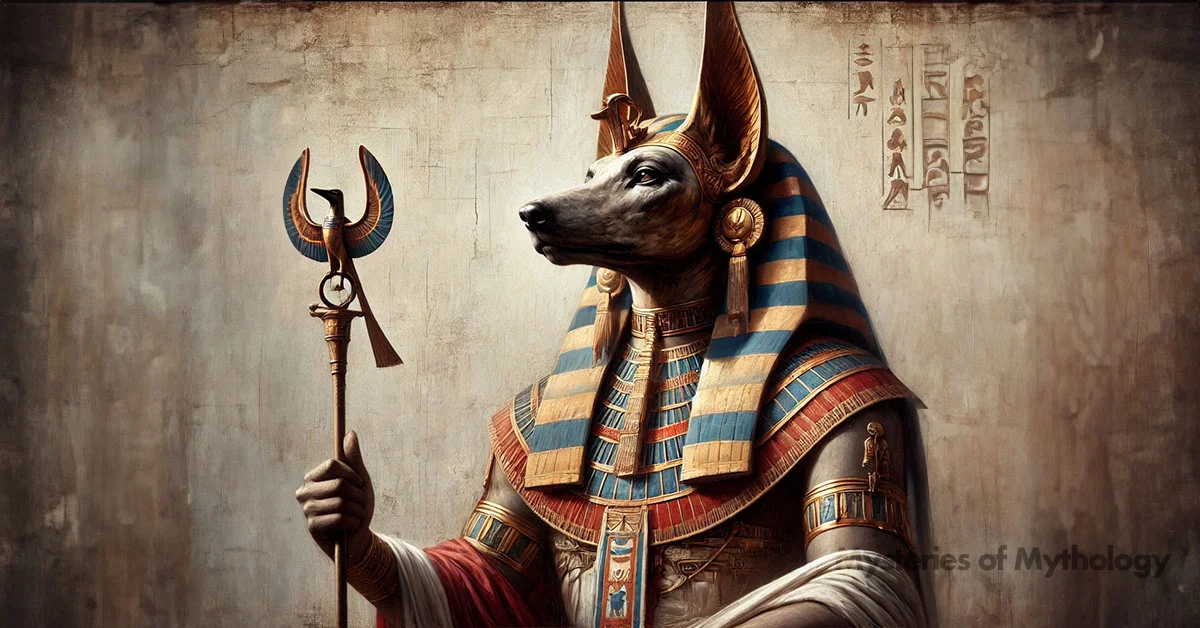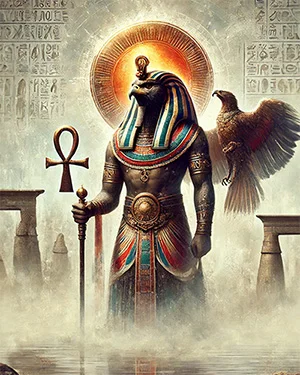Overview
Anubis was one of the most worshipped gods in ancient Egyptian mythology. He was the god associated with the afterlife and mummification and was recognised for his head of a jackal.
Anubis helped to guide souls to the afterlife, and after creating the process, he helped oversee the embalming process completed by his priests. People often think that there were black jackals in ancient Egypt, but his black colour symbolised both the decay of the body and the fertile soil of the Nile, which symbolised death and rebirth.
Anubis played a key role in the “Weighing of the Heart” ceremony, where he determined the fate of souls by weighing their hearts against Ma’at’s feather of truth.
Anubis is thought to be one of the oldest gods in Egyptian mythology and is often associated with Wepwawet, another jackal-headed god who, although also associated with finery rights, was better known as the ‘opener of the ways’.
In the earlier kingdoms, he was the primary god of the dead, but Anubis’s role evolved when Osiris became more prominent, shifting Anubis’s position to protector, embalmer, and guide of the dead.
Want to know more? Read on…
Watch the related video
Etymology
The name Anubis, which many people are familiar with, is actually derived from the Greek translation of the ancient Egyptian god’s original name, “Inpu,” “Inpw,” or “Anpu.” The name “Inpu” is thought to mean “a royal child,” yet it is also closely related to the word “inp,” which means “to decay.” This connection underscores Anubis’s primary role as the god of the dead and the mummification process.
Anubis’s association with death and the afterlife is deeply embedded in his name. The etymology highlights his essential functions in the preservation of bodies and guiding souls to the afterlife. His name reflects his critical role in ensuring the safe passage of the dead and the ancient Egyptians’ respect for the deceased.
Alternative names
Anubis is known by several other names and titles in different contexts and languages:
- Inpu/Inpw/Anpu: These are the original Egyptian names.
- Imy-ut: Meaning “He Who Is in the Place of Embalming,” highlighting his role in mummification.
- Khenty-Amentiu: Translated as “Foremost of the Westerners,” as the land of the dead was thought to be in the west, where the sun set.
- Neb-Ta-Djeser: Meaning “Lord of the Sacred Land,” and refers to his dominion over burial grounds.
- He Who is Upon his Sacred Mountain: Emphasizing his protective role over tombs and burial sites.
- Ruler of the Nine Bows: Signifying his power over enemies.
- The Dog who Swallows Millions: Reflecting his fearsome aspect and that all will meet him in death.
- Master of Secrets: Highlighting his knowledge of mummification and the afterlife.
- Foremost of the Divine Booth: Indicating his leading position among the gods involved in death and burial rituals
Pronunciation
ENGLISH
Anubis
Ancient Egyptian
(Inpw)
PHONETIC
ah-NOO-bis
IPA
əˈnjuːbɪs
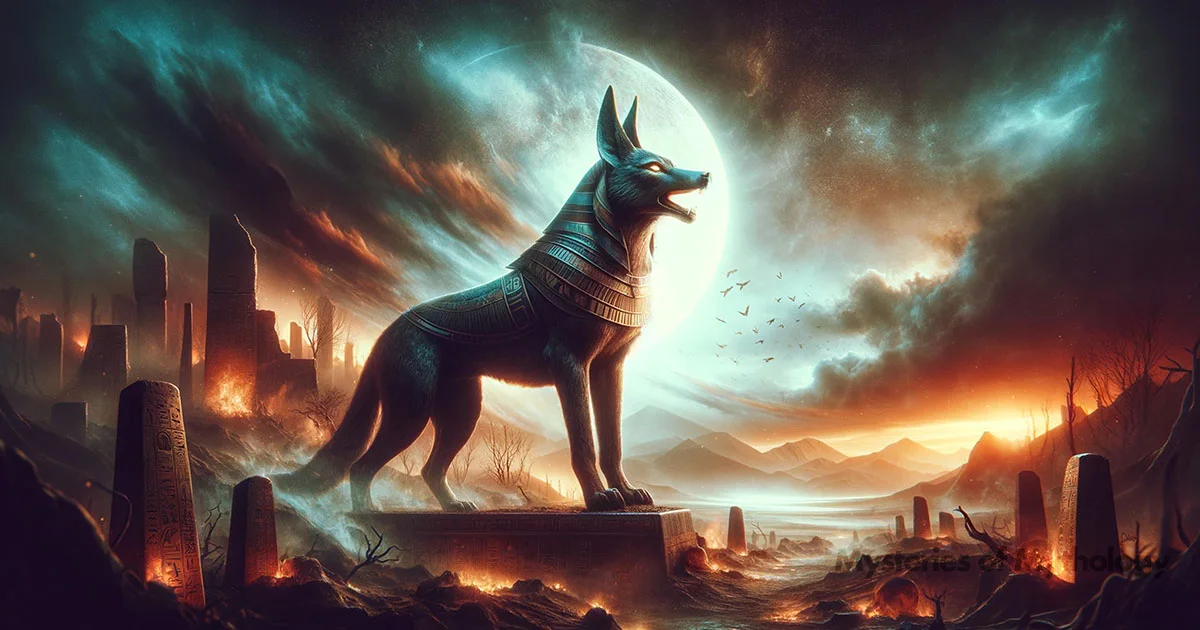
Attributes
Anubis is easily recognised by his distinctive appearance, featuring the body of a man and the head of a jackal or a full jackal-dog form. The ancient Egyptians chose the jackal because it was often seen around cemeteries, scavenging for remains. This association with graves led to Anubis being linked with the afterlife. By associating Anubis with the jackal, the Egyptians hoped to protect their deceased loved ones from scavengers and ensure their safe passage into the afterlife.
Anubis is typically depicted in black, a colour symbolising both the decaying flesh and the fertile soil of the Nile, linking death with the promise of rebirth. This dual symbolism of death and rebirth is central to his identity.
He is associated with various symbols, including the flail, which he holds as a sign of authority, and the ankh (☥), symbolising life. His vigilant and protective nature is emphasised by his role in overseeing the mummification process and safeguarding the deceased on their journey to the afterlife. Anubis is often depicted with scales, highlighting his crucial role in the Weighing of the Heart ceremony, where he determines the fate of souls by balancing their hearts against the feather of Ma’at.
Anubis’s role as a protector and guide of souls showcases his compassionate and vigilant nature. His connection to the afterlife rituals and his portrayal as a guardian emphasise his significance in ancient Egyptian mythology.
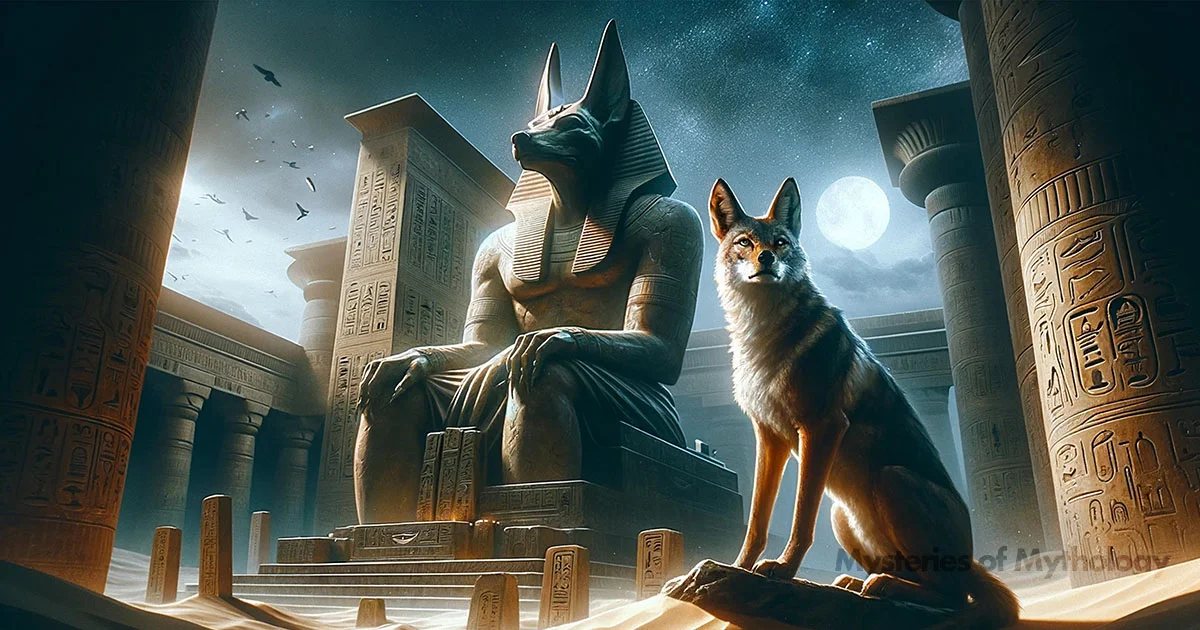
Family
The background of Anubis’ family varies across different periods of ancient Egyptian history. During the Predynastic Period (c. 6000-3150 BCE), the Early Dynastic Period (c. 3150-2613 BCE), and the Old Kingdom (c. 2613-2181 BCE), Anubis was considered the son of Ra, the sun god, and Hesat, a cow goddess often associated with Hathor. In these early periods, he was regarded as the sole god of the dead.
In the Middle Kingdom (c. 2055-1650 BCE) and the New Kingdom (c. 1570-1069 BCE), the mythology surrounding Anubis evolved. Anubis became more closely associated with Osiris, the god of the afterlife. One prominent myth from this era describes Anubis as the son of Nephthys and Osiris, conceived during an affair. Nephthys, fearing the wrath of her husband Set, abandoned the infant Anubis. Isis, Osiris’s wife and Nephthys’s sister, found and raised Anubis. This myth intertwines Anubis’s fate with Osiris and reinforces his role in funerary practices and the afterlife.
In some versions of the myth, Set is considered the father of Anubis. Again, Nephthys, fearing Set’s wrath, abandoned Anubis, who was then found and raised by Isis.
Anubis is also associated with his consort, Anput, who shares many of his roles related to funerary rites and the protection of the dead. Together, they have a daughter named Kebechet (Qebhet), a goddess who provides cool, refreshing water to the souls of the dead as they await judgment in the afterlife. Kebechet’s role as a purifier highlights the significance of water in the ritual processes and the promise of refreshment and renewal for the deceased.
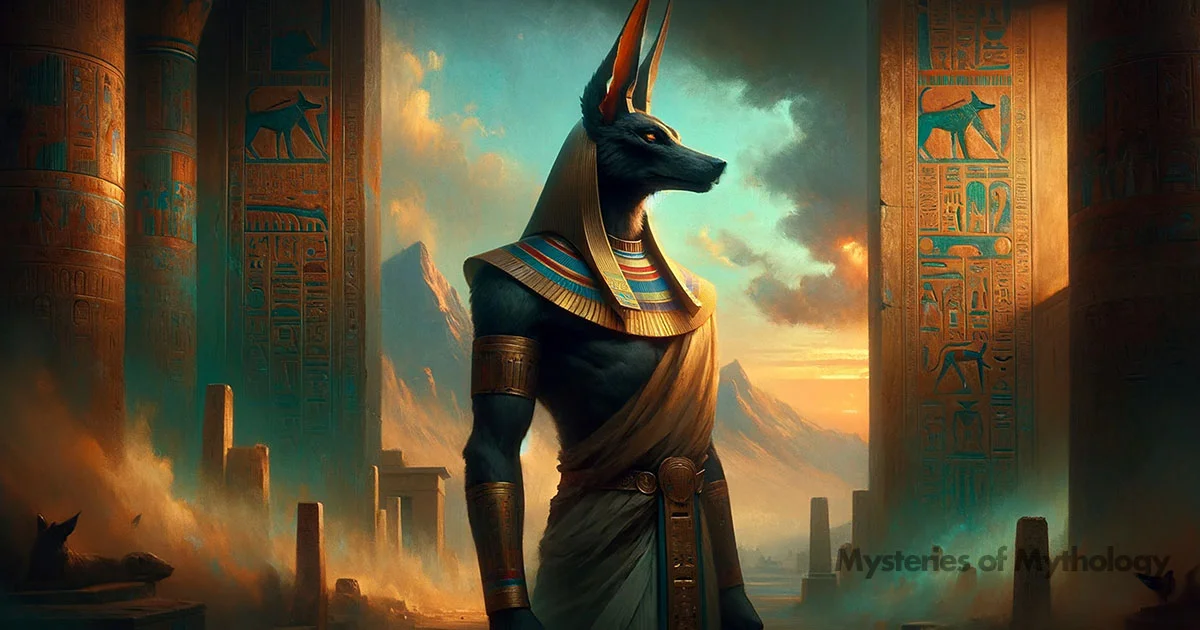
Family Tree
Parents
Father
Ra (Pre Middle Kingdom), Osiris (Post Middle Kingdom), Set (alternative)
Mother
Hesat (pre-Middle Kingdom), Nephthys (Post Middle Kingdom)
Consorts
Wife
Anput
Siblings
Brothers
Horus, Babi, Sopdet, Wepwawet
Children
Daughters
Kebechet
Mythology
Origin Story
The story of Anubis’s birth is filled with themes of infidelity, fear, abandonment, and the compassionate love of a goddess. Anubis’s mother, Nephthys, was the goddess of mourning, night, childbirth, the dead, protection, magic, health, embalming, and beer.
Nephthys secretly loved Osiris, her sister’s husband, the god of fertility and agriculture. Her own husband, Set, was the god of storms, disorder, and violence. The rivalry between Osiris and Set was well-known, making Nephthys’s attraction to Osiris particularly dangerous.
One night, Nephthys disguised herself as her sister Isis and seduced Osiris, resulting in her becoming pregnant and giving birth to Anubis. Fearing Set’s wrath if he discovered the illegitimate child, Nephthys abandoned the newborn Anubis to protect herself and the baby.
Isis, while walking along the Nile Delta, discovered the infant Anubis. Recognising the child, Isis, the goddess of love, magic, and motherhood, raised him as her own. This act of compassion and care by Isis intertwined Anubis’s fate with that of Osiris and solidified his role in funerary practices and the afterlife.
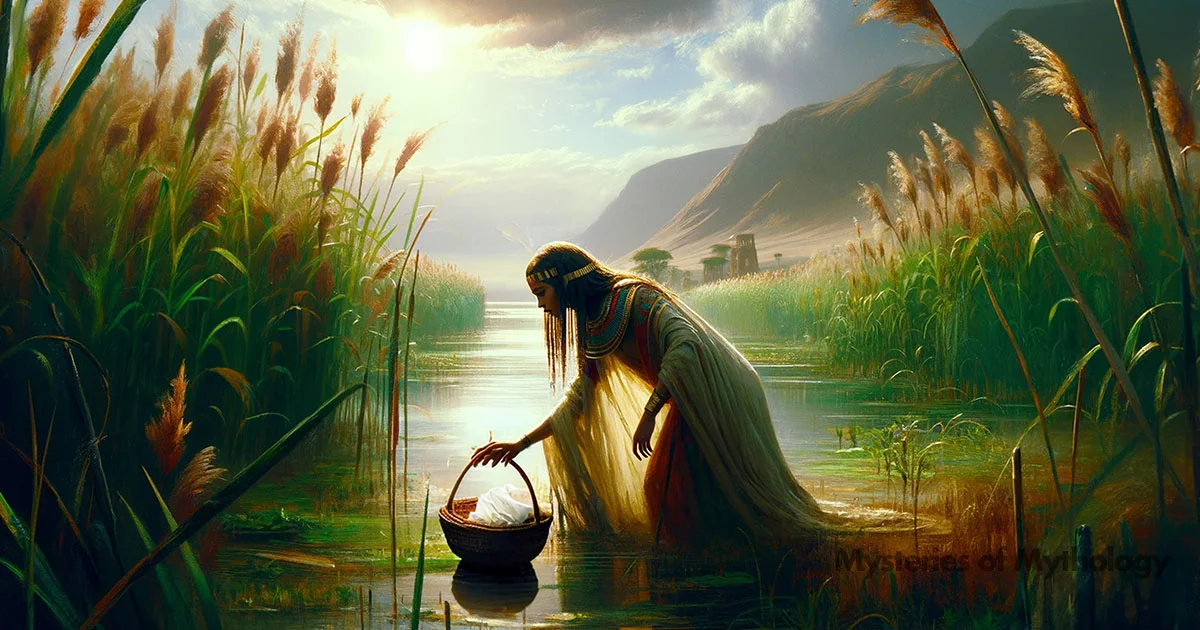
Role in Mummification and the Afterlife
Anubis played a crucial role in ancient Egyptian mythology, particularly in relation to mummification and the afterlife. Initially, Anubis was regarded as the sole god of the dead, but his role evolved following the myth of Osiris. After Osiris, the king of Egypt, was betrayed and murdered by his jealous brother Set, Osiris’s body was dismembered into fourteen pieces and scattered across Egypt. Osiris’s wife, Isis, set out to retrieve her husband’s body parts and, with the help of her sister Nephthys and the god of wisdom, Thoth, she managed to gather all the pieces except for his penis, which she replaced with a gold replica.
After Osiris’s body was reassembled, Anubis used linen strips and embalming spells to preserve it, which was considered the first mummification and was crucial for Osiris’s resurrection. Anubis was meticulous in perfecting the techniques necessary for preserving the body, ensuring that every step was conducted with precision and reverence.
The embalming process began with the “Opening of the Mouth” ceremony, a rite performed to restore the deceased’s senses, symbolising the reawakening of the body for the afterlife. Anubis was often depicted holding the tools of this ceremony, guiding the priests as they performed these sacred rites.
Apart from physical preservation, Anubis also played a vital role in the spiritual aspects of the afterlife. He guided the souls of the dead through the perilous journey to the underworld, offering protection from malevolent spirits and ensuring their safe passage. His role as a guide of souls portrayed him as a compassionate and vigilant protector.
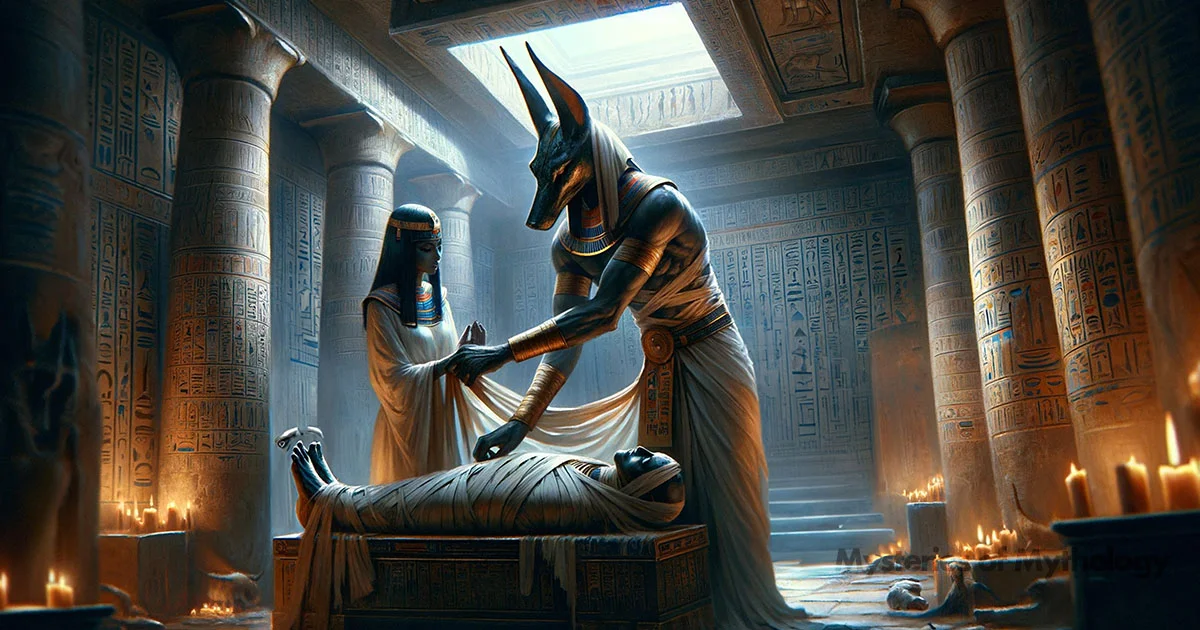
Following Osiris’s resurrection, Osiris became the ruler of the underworld, and Anubis, who had previously presided over the underworld, took on the role of Osiris’s assistant, overseeing the mummification process and protecting graves. He also oversaw the Hall of Truth, where the hearts of the deceased were weighed against the feather of Ma’at to determine their fate in the afterlife.
Anubis’s guardianship extended beyond the embalming chamber. According to myth, Set attempted to desecrate Osiris’s tomb by transforming into a leopard. Anubis caught Set and branded his skin with a hot iron, which explained the origin of leopards’ spots and why priests wore leopard skins during mummification rituals as a tribute to Anubis’s victory.
Weighing of the Heart Ceremony
The Weighing of the Heart ceremony is a crucial part of the ancient Egyptian belief about the journey of a soul. Anubis plays a central role in this process. The ceremony takes place in the Hall of Ma’at, the goddess of truth and justice. During the ceremony, the heart of the deceased, believed to contain the soul and its deeds, is weighed against the feather of Ma’at, which symbolises absolute truth and justice and serves as the ultimate measure of purity.
Before the heart can be weighed, the soul has to navigate the Duat, or underworld, which is filled with challenges, trials, and dangerous landscapes, including fiery lakes, serpent-filled caverns, and demonic guardians. The journey is perilous and tests the soul’s worthiness before it even reaches the Hall of Ma’at.
When arriving at the Hall of Ma’at, the deceased stands before a panel of 42 divine judges, each representing a different aspect of Ma’at. Here, the deceased makes a declaration known as the Negative Confession, proclaiming their innocence of various sins and wrongdoings committed during their life. This proclamation is a crucial part of proving their worthiness to enter the afterlife.
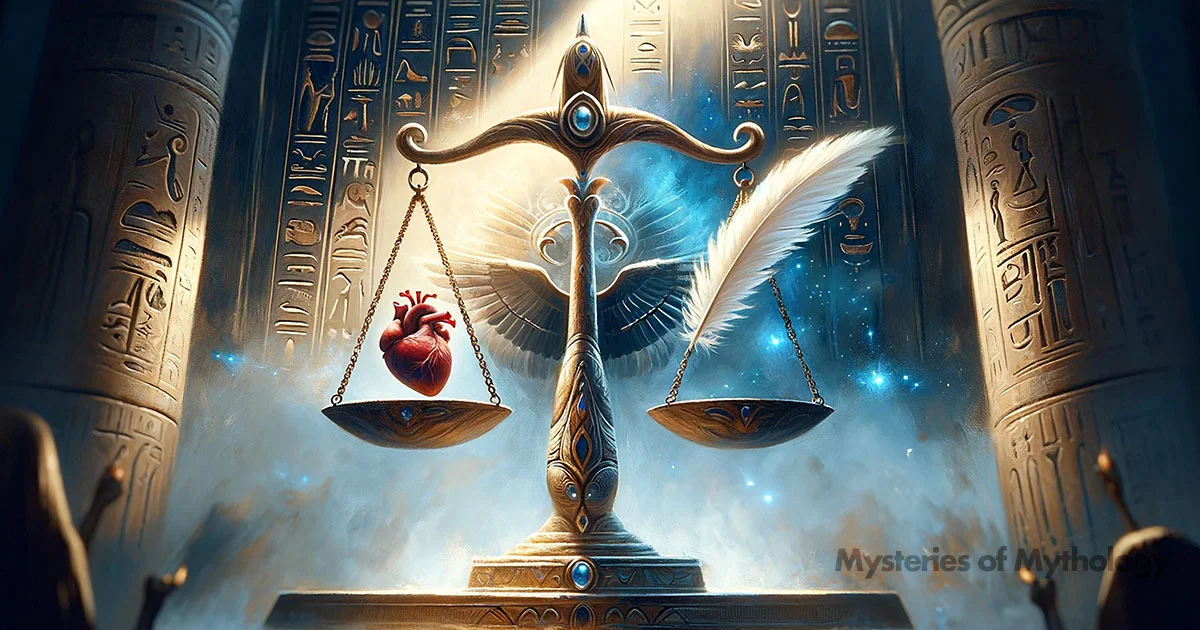
Anubis guides the soul to the scales and ensures the process is conducted with the utmost fairness and accuracy. The heart is placed on one side of the scale, while the feather of Ma’at is placed on the other. If the heart is lighter or equal in weight to the feather, it indicates that the soul is pure and free from the burden of sin. This means the deceased has led a life in accordance with Ma’at’s principles and is thus granted entry into Aaru, the Field of Reeds, a realm of eternal contentment and bliss.
However, if the heart is heavier than the feather, made heavy with sin and wrongdoing, it will tip the scales. In this case, the heart is fed to Ammit, the devourer, a fearsome creature with the head of a crocodile, the body of a lion, and the hindquarters of a hippopotamus. This act condemns the soul to oblivion, denying them entry to the afterlife and any form of rebirth.
Anubis and Hermes
During the Hellenistic period, the roles of Anubis and the Greek god Hermes combined to create a new god called Hermanubis. This happened as the Greeks encountered and adopted elements of Egyptian religion.
Hermanubis guided souls to the afterlife, combining the duties of both Anubis and Hermes. He was often shown with the body of a man and the head of a jackal, holding Hermes’s staff, the caduceus. This combination represented the mix of Greek and Egyptian beliefs about death and the afterlife, emphasizing both cultures’ focus on the transition of souls to the next world.
Worship
Worship of Anubis dates back to the Old Kingdom, around 2686–2181 BCE. He was revered as the protector of graves and the god of mummification. Temples and shrines dedicated to Anubis were found throughout Egypt, particularly in burial sites and necropolises. Priests of Anubis, known as “wab-priests,” played crucial roles in funeral rituals, overseeing the embalming process and performing ceremonies to ensure safe passage to the afterlife. Offerings of food, incense, and prayers were common practices to honour Anubis and seek his protection for the deceased.
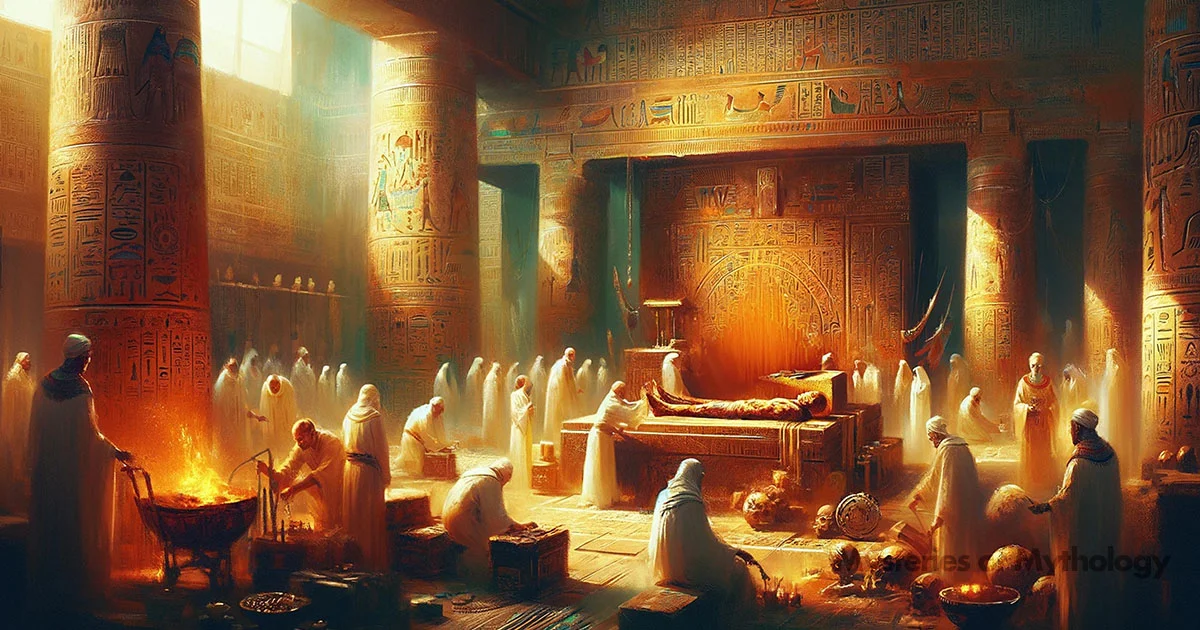
One of the significant sites dedicated to Anubis was the city of Cynopolis (“City of the Dog”), which served as a major centre of his worship. Anubis was honoured with elaborate ceremonies, and many cemeteries in the region featured statues and depictions of the jackal-headed god. The prominence of Anubis in funerary practices is also evident in the numerous amulets and inscriptions found in tombs designed to invoke his protection and guidance for the deceased.
The annual “Beautiful Festival of the Valley” was another significant event where Anubis was venerated. During this festival, Egyptians would visit the tombs of their ancestors, offering food and gifts to the deceased, ensuring their well-being in the afterlife. Anubis was believed to play a vital role in these rituals, acting as a guardian and guide for the souls of the departed.
Anubis’s worship extended beyond ancient Egypt. During the Hellenistic period, his role merged with that of the Greek god Hermes, creating the syncretic deity Hermanubis. This fusion of beliefs highlights Anubis’s enduring influence and the respect he commanded across different cultures and eras.
Pop Culture
Anubis is one of the most recognisable gods from Egyptian mythology, making him a popular option in various forms of media, including films, television shows, video games, and literature. His striking appearance and association with death make him a compelling character for creative adaptations.
- Movies and TV Shows: Anubis is often featured in films and series that explore ancient Egypt, such as “The Mummy” franchise and “Stargate SG-1.” In these narratives, he is typically portrayed as a powerful and sometimes malevolent deity, reinforcing his association with the afterlife and judgment.
- Video Games: Anubis appears in numerous video games, such as the “Assassin’s Creed” series, where players can encounter him in quests related to Egyptian mythology. He is also a playable character in games like “SMITE,” where he is depicted as a formidable warrior with abilities rooted in his mythological powers.
- Literature: In Rick Riordan’s “The Kane Chronicles,” where Anubis aids the protagonists in their battle against chaos. In Neil Gaiman’s “American Gods,” Anubis appears as Mr. Jacquel.
Frequently Asked Questions
Is Anubis good or bad?
Anubis, the ancient Egyptian god of the afterlife, is neither inherently good nor bad. He is a protective deity who guides souls to the afterlife and oversees mummification and burial rites.
What is Anubis the god of?
Anubis is the god of mummification and the afterlife. He is also known for being the protector of graves and the guide for souls to the underworld.
What is the Anubis symbol?
The primary symbol of Anubis is the black jackal or a man with the head of a jackal. This symbolizes protection and his association with the afterlife.
How was Anubis killed?
Anubis, being a god, was not killed. In Egyptian mythology, gods are immortal, and there are no stories depicting the death of Anubis.
Which ancient Greek god is Anubis associated with?
Anubis is often associated with the Greek god Hermes. Both serve as psychopomps, guiding souls to the afterlife.
References
- Bard, Kathryn A. “An Introduction to the Archaeology of Ancient Egypt.” Wiley-Blackwell, 2015
- Hornung, Erik. “The Ancient Egyptian Books of the Afterlife.” Cornell University Press, 1999
- Pinch, Geraldine. “Egyptian Mythology: A Guide to the Gods, Goddesses, and Traditions of Ancient Egypt.” Oxford University Press, 2004
- Shaw, Ian. “The Oxford History of Ancient Egypt.” Oxford University Press, 2003
- Wilkinson, Richard H. “The Complete Gods and Goddesses of Ancient Egypt.” Thames & Hudson, 2003
- Tyldesley, Joyce. “The Mummy: A History of the Extraordinary Practices of Ancient Egypt.” Carlton Books, 2011
- Teeter, Emily. “Religion and Ritual in Ancient Egypt.” Cambridge University Press, 2011

